 Website:
Metrohm
Website:
Metrohm
Catalog excerpts

Petrochemical analysis Quality control of petroleum products
Open the catalog to page 1
Metrohm ... • is the global market leader in titration • offers a complete portfolio for NIR and Raman analysis, in addition to all of the methods of • ion analysis – titration, voltammetry, and ion chromatography • is a Swiss company and manufactures exclusively in Switzerland • grants a 3-year instrument warranty and a 10-year warranty on chemical suppressors for anion chromatography • provides you with unparalleled application expertise • offers you more than 1800 applications free of charge • supports you with dependable on-site service worldwide • is not listed on the stock exchange,...
Open the catalog to page 2
Metrohm – customized analysis for the petrochemical industry A demanding industry Crude oil is a highly complex mixture of hydrocarbons and other compounds that through desalting, distillation, and conversion is transformed into higher quality hydrocarbons. This refining is demanding and requires precise and reliable analysis. You can count on our support Not only do we provide you with the right instrumentation but with complete solutions for the particular task at hand. Your partners at Metrohm are experienced professionals who help you with customized application support and service. As...
Open the catalog to page 3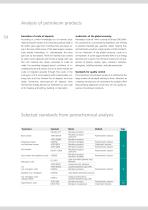
Analysis of petroleum products 04 Formation of crude oil deposits According to current knowledge our oil reserves origi nated during the Jurassic and Cretaceous periods (200 to 65 million years ago) from microbial flora and fauna living in the seas. While some of the dead organic resi ues d were directly mineralized, i.e., decomposed, the other part sank to the seabed. There the material was covered by other marine deposits and formed a sludge with very fine rock material that slowly converted to crude oil under the prevailing biogeochemical conditions of in creased pressure and...
Open the catalog to page 4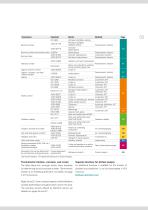
Petroleum distillates, alkenes Petroleum distillates Aliphatic alkenes Aromatic hydrocarbons Hydrocarbons Aromatic hydrocarbons Petroleum hydrocarbons Bromine number ASTM D5776 Bromine number and bromine index UOP304 ASTM D1492 Bromine index ASTM D2710 Resins, raw materials for varnishes, primary alcohols, glycols, fats Crude oil Crude oil Petroleum products Crude oil Crude oil Petroleum products Petroleum hydrocarbons Solvents Crude oil Crude oil Crude oil, lubricating oil, solvents Highly volatile solvents Turpentine General Natural gas Gaseous fuels, gases Fatty acid methyl esters (B100)...
Open the catalog to page 5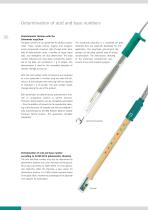
Determination of acid and base numbers 06 Potentiometric titration with the Solvotrode easyClean The base number is a sum parameter for alkaline components. These include primary organic and inorganic amino compounds. However, salts of weak acids, basic salts of polycarboxylic acids, a number of heavy metal salts, and detergents are also determined. The base number indicates how many basic components, expres sed as mg KOH, are contained in 1 g of sample. This de termination is used for the immediate detection of pro duct changes during use. The Solvotrode easyClean is a combined...
Open the catalog to page 6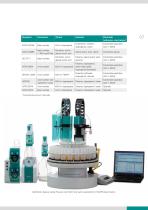
Electrode (reference electrolyte) Base number Chloroform, toluene, isopropanol, water Solvotrode easyClean (LiCl in EtOH) Base number Perchloric acid in > 300 mg KOH/g glacial acetic acid Glacial acetic acid, xylene Solvotrode special Base number Perchloric acid in glacial acetic acid Toluene, glacial acetic acid, acetone Solvotrode easyClean (LiCl in EtOH) Acid number Toluene, isopropanol, KOH in isopropanol water (lubricants), isopropanol (biodiesel) Dimethyl sulfoxide, isopropanol, toluene Solvotrode easyClean (LiCl in EtOH) Solvotrode easyClean (LiCl in EtOH) Acid number and KOH in...
Open the catalog to page 7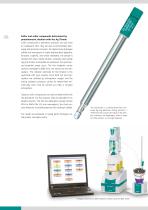
Sulfur and sulfur compounds determined by potentiometric titration with the Ag Titrode Sulfur compounds in petroleum products not only have an unpleasant odor, they are also environmentally damaging and promote corrosion. For determining hydrogen sulfide and mercaptans in liquid hydrocarbons (gasoline, kerosene, naphtha, and similar distillates), the sample is titrated with silver nitrate solution, whereby silver sulfide (Ag2S) and silver mercaptide are produced. Two pronoun ced potential jumps occur. The first endpoint corres ponds to hydrogen sulfide (H2S), the second to the mercaptans....
Open the catalog to page 8
Thermometric titration: the ideal complement to potentiometric titration The principle Every chemical reaction is associated with a change in reaction enthalpy. This results in either an increase (exo- The advantages of thermometric titration are ease of h andling, control via tiamo software, and exceptionally short analysis times. Automation is particularly ad van tageous here, as it saves a great deal of time. The sensor re quires no calibration or maintenance and is ideally suited to aggressive sample matrices. There are two versions, one for HF-free and the other for...
Open the catalog to page 9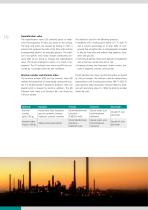
Saponification value The saponification value (SV) primarily serves to determine the proportion of fatty acid esters in the sample. The fatty acid esters are cleaved by boiling in KOH, a process that produces the salts of the fatty acids and the corresponding alcohol, for example, glycerol. The method is not specific since acidic sample constituents consume KOH and in doing so increase the saponification value. The titrant employed is c(HCl) = 0.5 mol/L in isopropanol. The SV indicates how many mg KOH are consumed by 1 g sample under the test conditions. Bromine number and bromine index The...
Open the catalog to page 10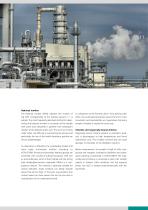
Hydroxyl number The hydroxyl number (OHN) indicates the number of mg KOH corresponding to the hydroxyl groups in 1 g sample. The most frequently described method for determining the hydroxyl number is conversion of the sample with acetic acid anhydride in pyridine with subsequent titration of the released acetic acid. The one-hour boiling under reflux, the difficulty in automating the process and particularly the use of the health-hazardous pyridine are serious disadvantages. An alternative is offered by the considerably simpler and more easily automated method according to ASTM E1899....
Open the catalog to page 11All Metrohm catalogs and technical brochures
-
Eco Titrator
8 Pages
-
110CSQD C1110CSQD
1 Pages
-
909 UV Digester
8 Pages
-
2060 Process Analyzer
12 Pages
-
Misa
8 Pages
-
ID KIT
4 Pages
-
Combustion Ion Chromatography
12 Pages
-
894 Professional CVS
20 Pages
-
892 Professional Rancimat
20 Pages
-
NIRS DS2500 Solids Analyzer
4 Pages
-
Monograph
46 Pages
-
Metrohm NIRSystems
16 Pages
-
SPELECRAMAN
2 Pages
-
SPELEC
2 Pages
-
946 Portable VA Analyzer
4 Pages
-
815 Robotic Soliprep
12 Pages
-
756/831 Coulometer
4 Pages
-
900 Touch Control
4 Pages
-
V–211
2 Pages
-
Food analysis
32 Pages
-
780 pH/ 781 pH Meter
12 Pages
-
930 Compact IC Flex
12 Pages
-
875 KF Gas Analyzer
4 Pages
-
899 Coulometer
8 Pages
-
870 KF Titrino plus
8 Pages
-
848/877 Titrino plus
8 Pages
-
Metrohm Image Brochure
15 Pages
-
NIRS DS2500 Analyzer
4 Pages
-
NIRS Analyzer Pro
8 Pages
-
tiamo TM - Titration and more
28 Pages
-
898 XYZ Sample Changer
8 Pages
-
904/905/906/907 Titrando
24 Pages























































